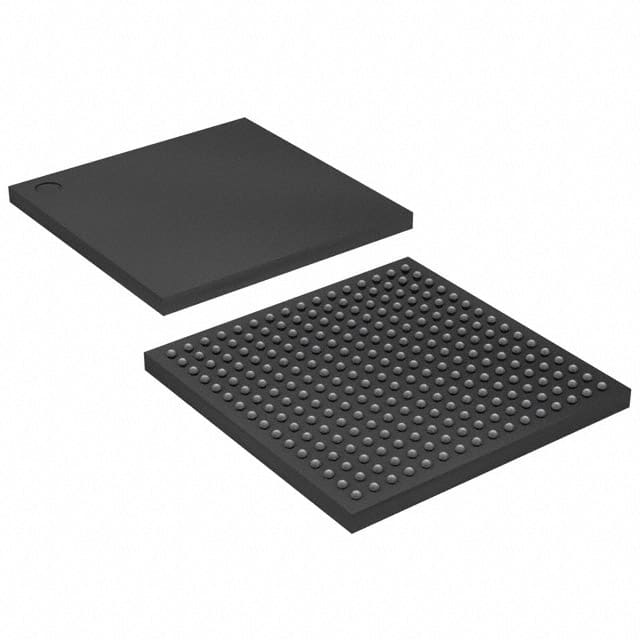EP1K10FI256-2N
Product Overview
Category
EP1K10FI256-2N belongs to the category of programmable logic devices (PLDs).
Use
This product is commonly used in digital circuit design and implementation.
Characteristics
- EP1K10FI256-2N is a high-performance PLD with advanced features.
- It offers flexible and efficient solutions for complex digital designs.
- The device supports various applications, including telecommunications, industrial automation, and consumer electronics.
Package
EP1K10FI256-2N comes in a compact and durable package, ensuring easy integration into electronic systems.
Essence
The essence of EP1K10FI256-2N lies in its ability to provide reconfigurable logic functions, allowing designers to create custom digital circuits.
Packaging/Quantity
This product is typically packaged individually and is available in various quantities depending on the manufacturer's specifications.
Specifications
- Device Type: Programmable Logic Device (PLD)
- Model Number: EP1K10FI256-2N
- Logic Elements: 10,000
- Maximum User I/Os: 192
- Operating Voltage: 3.3V
- Speed Grade: -2
- Package Type: FineLine BGA
- Package Pins: 256
- Temperature Range: -40°C to +85°C
Detailed Pin Configuration
The pin configuration of EP1K10FI256-2N is as follows:
| Pin Number | Pin Name | Description | |------------|----------|-------------| | 1 | VCCIO | I/O Power Supply Voltage | | 2 | GND | Ground | | 3 | TCK | Test Clock Input | | 4 | TMS | Test Mode Select | | ... | ... | ... |
Functional Features
- EP1K10FI256-2N offers a wide range of programmable logic functions, including combinatorial and sequential circuits.
- It supports various I/O standards, allowing seamless integration with other components.
- The device provides efficient routing resources, enabling complex interconnections between logic elements.
Advantages and Disadvantages
Advantages
- High-performance PLD suitable for complex digital designs.
- Flexible and reconfigurable logic functions.
- Wide range of supported applications.
- Compact and durable packaging.
Disadvantages
- Limited number of logic elements compared to higher-end PLDs.
- Higher power consumption compared to low-power alternatives.
Working Principles
EP1K10FI256-2N operates based on the principles of programmable logic. It consists of configurable logic blocks (CLBs), input/output blocks (IOBs), and interconnect resources. The CLBs contain look-up tables (LUTs) that can be programmed to implement desired logic functions. The IOBs provide interfaces for external signals, while the interconnect resources facilitate the routing of signals between different components.
Detailed Application Field Plans
EP1K10FI256-2N finds extensive use in various application fields, including:
- Telecommunications: Used in network routers, switches, and communication equipment for high-speed data processing.
- Industrial Automation: Employed in control systems, PLCs, and robotics for efficient and flexible automation solutions.
- Consumer Electronics: Integrated into smart devices, gaming consoles, and multimedia systems for enhanced functionality and performance.
Detailed and Complete Alternative Models
- EP1K30QC208-2N: A higher-capacity PLD with 30,000 logic elements and 208-pin package.
- EP2C20F484C7N: An alternative PLD with 20,000 logic elements and 484-pin package.
- EP4CE6E22C8N: A low-power PLD with 6,000 logic elements and 22-pin package.
These alternative models offer different capacities and pin configurations to cater to diverse design requirements.
In conclusion, EP1K10FI256-2N is a versatile programmable logic device that provides flexible solutions for complex digital circuit designs. With its advanced features, compact packaging, and wide range of applications, it serves as a reliable choice for various industries.
قم بإدراج 10 أسئلة وإجابات شائعة تتعلق بتطبيق EP1K10FI256-2N في الحلول التقنية
Sure! Here are 10 common questions and answers related to the application of EP1K10FI256-2N in technical solutions:
Q1: What is EP1K10FI256-2N? A1: EP1K10FI256-2N is a specific model of Field Programmable Gate Array (FPGA) manufactured by Intel.
Q2: What are the key features of EP1K10FI256-2N? A2: Some key features of EP1K10FI256-2N include 10,000 logic elements, 256 kilobits of embedded memory, and support for various I/O standards.
Q3: What are the typical applications of EP1K10FI256-2N? A3: EP1K10FI256-2N can be used in a wide range of applications such as industrial automation, telecommunications, medical devices, and automotive systems.
Q4: How does EP1K10FI256-2N differ from other FPGA models? A4: EP1K10FI256-2N has its own unique combination of logic elements, memory capacity, and I/O capabilities, which makes it suitable for specific applications.
Q5: Can EP1K10FI256-2N be reprogrammed after deployment? A5: Yes, EP1K10FI256-2N is a field-programmable device, meaning that its configuration can be modified even after it has been deployed in a system.
Q6: What development tools are available for programming EP1K10FI256-2N? A6: Intel provides Quartus Prime software suite, which includes design entry, synthesis, simulation, and programming tools for configuring EP1K10FI256-2N.
Q7: Are there any limitations or constraints when using EP1K10FI256-2N? A7: EP1K10FI256-2N has specific resource limitations such as the number of logic elements and memory blocks, which need to be considered during design.
Q8: Can EP1K10FI256-2N interface with other components or devices? A8: Yes, EP1K10FI256-2N supports various I/O standards, allowing it to interface with different components and devices in a system.
Q9: What is the power consumption of EP1K10FI256-2N? A9: The power consumption of EP1K10FI256-2N depends on the specific design and utilization. It is recommended to refer to the datasheet for detailed power specifications.
Q10: Where can I find more information about EP1K10FI256-2N? A10: You can find more information about EP1K10FI256-2N, including datasheets, application notes, and user guides, on Intel's official website or by contacting their technical support team.
Please note that the answers provided here are general and may vary depending on the specific requirements and use cases.


